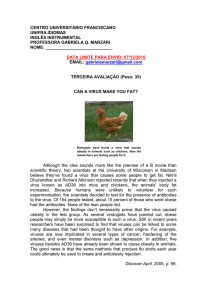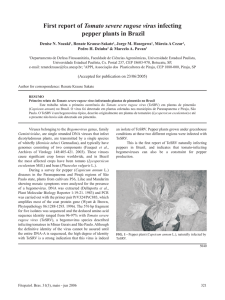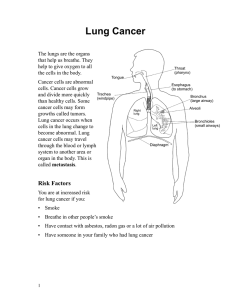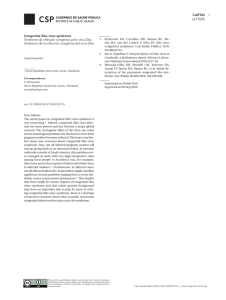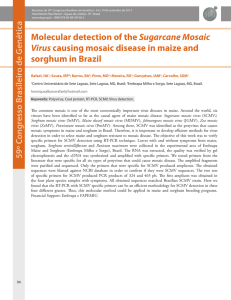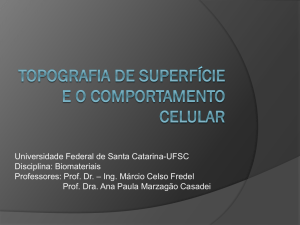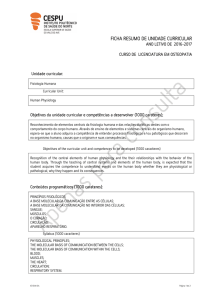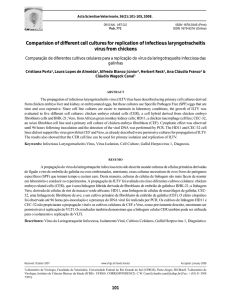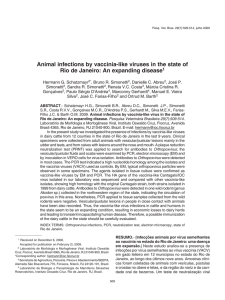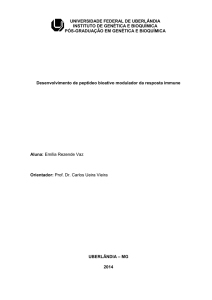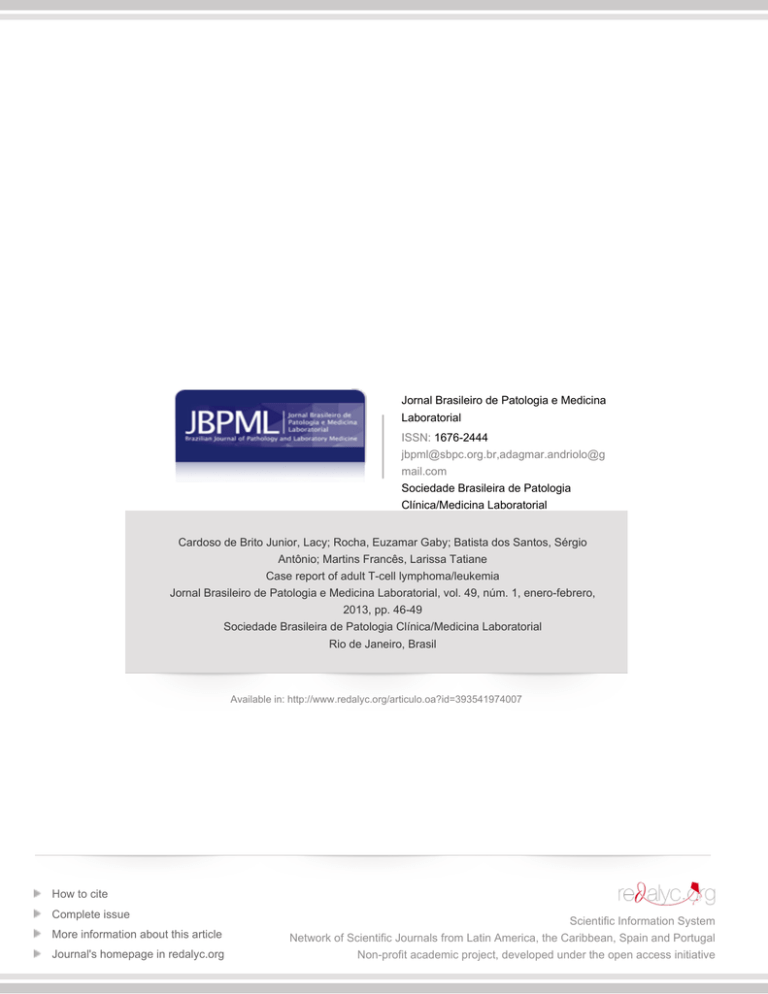
Jornal Brasileiro de Patologia e Medicina
Laboratorial
ISSN: 1676-2444
[email protected],adagmar.andriolo@g
mail.com
Sociedade Brasileira de Patologia
Clínica/Medicina Laboratorial
Brasil
Cardoso de Brito Junior, Lacy; Rocha, Euzamar Gaby; Batista dos Santos, Sérgio
Antônio; Martins Francês, Larissa Tatiane
Case report of adult T-cell lymphoma/leukemia
Jornal Brasileiro de Patologia e Medicina Laboratorial, vol. 49, núm. 1, enero-febrero,
2013, pp. 46-49
Sociedade Brasileira de Patologia Clínica/Medicina Laboratorial
Rio de Janeiro, Brasil
Available in: http://www.redalyc.org/articulo.oa?id=393541974007
How to cite
Complete issue
More information about this article
Journal's homepage in redalyc.org
Scientific Information System
Network of Scientific Journals from Latin America, the Caribbean, Spain and Portugal
Non-profit academic project, developed under the open access initiative
case report
Case report of adult T-cell lymphoma/leukemia
Relato de caso de linfoma/leucemia de células T do adulto
Lacy Cardoso de Brito Junior1; Euzamar Gaby Rocha2; Sérgio Antônio Batista dos Santos3; Larissa Tatiane Martins Francês4
Abstract
The adult T-cell leukemia/lymphoma (ATLL) is a rare type of lymphoma caused by human T lymphotropic virus type 1 (HTLV-1). The clinical
manifestations include cutaneous lesions, adenopathies, myelopathy/ tropical spastic paraparesis, uveitis, ophthalmological diseases, leukocytosis
with lymphocytosis and atypical lymphocytes. The main objective of this study was to report a case of a female patient with ATLL, a farmer
with leukocytosis, lymphocytosis, bilateral ocular erythema, cervical lymphadenopathy, in the abdominal visceromegalies and with positive
markers for T-cell lymphocytes (CD45, CD2, CD3, CD5, CD4 and CD25). Although ATLL is a rare disease, its delayed diagnosis may lead to serious
complications and fatal outcome.
Key words: T cell leukemia; flow cytometry; human T-lymphotropic virus 1; chronic lymphoproliferative disorders.
Introduction
The adult T-cell leukemia/lymphoma (ATLL) is a mature T cell
neoplasia commonly associated with infections caused by human
T lymphotropic virus type 1 (HTLV-1)(2, 12, 15). Nevertheless, only 2%
to 5% of infected patients ultimately develop ATLL(2), mainly in
regions where HTLV-1 infections are endemic, namely in Japan(7, 12). In
addition to ATLL, other diseases are connected with HTVL-1 infection
such as mielopathy/tropical spastic paraparesis (HAM/TSP), uveitis
and infectious dermatitis during childhood(12). Despite the fact that
HTLV-1 infections are regarded as endemic in Brazil and highly
prevalent in Bahia, Pernambuco and Pará, HTVL-1 and HTVL-2
infections are present in all regions, though with low prevalence
among the general population(3, 9).
ATLL pathogenesis, though not totally elucidated in humans, is
linked with CD4T cell and HTLV-1 infections(17) and some risk factors
such as the following : (1) gender, with higher prevalence among
women due to their higher vulnerability to sexual transmission(4); (2)
heredity, linked with higher genetic predisposition to the development
of this type of leukemia(18); (3) direct correlation between the increase
in atypical lymphocytes, proviral load and the aggravation of clinical
symptoms(6, 11, 13); (4) low levels of serum HTLV-1 TAX antibody (escape
mechanism of infected cells), inasmuch as in normal conditions
TAX is able to cause intracellular changes in CD4+ lymphocytes
and induce immunological response(5, 10, 16); (5) HTVL-1 vertical
transmission via breast-feeding(1, 2, 18).
The clinical and laboratory features associated with ATLL are
the following: skin lesions, adenopathies, hypercalcemia, increase
in lactate dehydrogenase (LDH). alteration in the number of
leucocytes in peripheral blood with presence of atypical lymphocytes
(flower cells), increase in anti-HTLV-1 antibody, and presence of
neoplastic T lymphoid cells with immunophenotype connected with
CD2+,CD3+,CD4+ e CD25+(2, 3, 8).
Therefore, the objectives of the present investigation were to
report the case of a patient with ATLL and review some aspects related
to this disease.
Case report
A 53-year-old female patient, a farmer from Santa Izabel-Pará,
was admitted at the Fundação Centro de Hemoterapia e Hematologia
do Pará (HEMOPA) on July 29 2010. The patient presented clinical
history of ophthalmological problem, erythema with tearing and
sensation of foreign body in eye, finger and toe nails had fallen off,
cyanosis of extremities, swollen right ankle and breast discharge
that remained clinically unsolved for over 19 years. Physical exam
revealed cyanosis of extremities (feet and hands, bilateral ocular
erythema with opacification of the right cornea, painless bilateral
cervical lymphadenopathy with no visceromegalies or cutaneous
lesions.
First submission on 28/02/12; last submission on 11/07/12; accepted for publication on 25/09/12; published on 20/02/13
1. Doctor in Medical Science with emphasis on Experimental Pathology from Faculdade de Medicina de Ribeirão Preto da Universidade de São Paulo (FMRPUSP); head of the
Graduation and Post Graduation Service of Fundação Hospital de Clínicas Gaspar Viana.
2. Specialist in Hematology from Universidade Estadual do Rio de Janeiro (UERJ); hematologist at the Fundação Centro de Hemoterapia e Hematologia do Pará (HEMOPA).
3. Specialist in Hemotherapy from Universidade do Estado do Pará; doctor at the Hemotherapy and Hematology HEMOPA.
4. Specialist in Hematology from Santa Casa de Misericórdia de São Paulo; hematologist at the Hemotherapy and Hematology HEMOPA.
46
Lacy Cardoso de Brito Junior; Euzamar Gaby Rocha; Sérgio Antônio Batista dos Santos; Larissa Tatiane Martins Francês
Clinical exams were performed at admittance on July 15 2010
and patient’s return was scheduled for July 30. The exams yielded
the following results: (1) hemogram – erythrocytes = 4.54 million/
mm3; hemoglobin = 12.8 g/dl; hematocrit = 37.5%; red cell
distribution width (RDW) = 15.8%; platelets = 207 thousand/mm3,
leucocytes = 38,000/mm3, with 86% of lymphocytes from which 15%
showed moderate nucleocytoplasmatic relation, pleomorphic nuclei
(tetra-lobed nuclei) and basophilic cytoplasm without granules
(Figure 1); (2) negative serology for Chagas disease, human
immunodeficiency virus (HIV) 1 and 2, syphilis and hepatitis; (3)
tests for antinuclear factor, Ro/SS-A and La/SS-B autoantibodies,
anti-deoxyribonucleic acid, rheumatoid factor and antistreptolysin
O were also non reactive; (4) negative C reactive protein (CRP);
(5) negative direct Coombs; (6) negative lupus anticoagulant. On
the same day of collection, other exams were required (hemogram,
myelogram and immunophenotyping by flow cytometry) in order to
exclude the diagnostic possibility of chronic lymphocytic leukemia/
small lymphocytic lymphoma.
On September 22 2010 the exams yielded the following results:
(1) hemogram – erythrocytes = 4.37 million/mm3; hemoglobin
= 13.8 g/dl; hematocrit = 38.8%; RDW = 16.6%; platelets = 201
thousand/mm3; leucocytes = 44,700/mm3 with 83% of lymphocytes;
(2) myelogram with normal cellularity for granulocytic,
erythrocytic and megacariocytic activity and hyper cellularity of
lymphoplasmacytic activity with prevalence of mature lymphocytes
with cleaved nuclei, suggesting lymphoproliferative neoplasia; (3)
immunophenotyping by flow cytometry of peripheral blood showed
the presence of 69% of mature T lymphocytes with CD45, CD5, CD2,
Figure 1 – Histograms of immunophenotyping by flow cytometry with mature T
lymphocyte populations
(A) CD2+ and negative for CD7; (B) CD5+ and negative for CD20; (C) CD4+ and
negative for CD8; (D) CD25+ and negative for CD103.
RPE: R-phycoerythrin; FITC: fluorescein.
47
CD25, CD4 and CD3 expression in the membrane and in the cytoplasm
and absence of CD7 and CD8 expression (Figure 2), suggesting ATLL.
Serologic analysis (reactive) and PCR (positive) were recommended
for HTLV-1 and 2. On November 08 2010 the patient was referred to
the Hematology center of Ophir Loyola Hospital for chemotherapeutic
treatment.
As this is a retrospective study, the clinical case was referred to the
Ethical Research Committee of HEMOPA Foundation for pre-informed
consent according to standard procedure in this area of investigation.
Figure 2 – Photomicrographs showing pleomorphic morphology (tetra-lobed) of T
lymphocyte nuclei (flower cell), which are associated with HTVL infection and are observed
in the peripheral blood
HTLV: Human T-lymphotropic virus.
Discussion
According to the medical literature, ATLL diagnosis is rare among
chronic lymphoproliferative neoplasias. It affects individuals in their
third decade of life, mainly between 40 to 60 years of age. As it has
clinical features that are similar to other chronic lymphoproliferative
neoplasias, its diagnosis remains underestimated in several counties,
including Brazil(14).
Cutaneous lesions, adenopathies, ocular ulcerations and changes
in the number of leucocytes with lymphocytosis in peripheral blood
are some of the most frequent features of ATLL and other chronic
lymphoproliferative neoplasias(2, 15).
At the present study, in accordance with literature data(2, 8, 10),
this pathology was associated with the female gender, after the third
decade of live, with clinical history of leukocytosis, lymphocytosis and
presence of atypical lymphoid shapes (flower cell).
Clinical laboratory exams commonly altered by ATLL are the
following: calcium dosage and lactic dehydrogenase (DHL), which
are relevant to the clinical classification of ATLL (acute, chronic,
smoldering or lymphoma type)(2, 3, 8, 12); uric acide and Beta 2
microglobulin, albumin, renal and hepatic functions, which are
import to assess tumor load; ophthalmologic exam to assess the
causes of ocular erythema and opacification of the right cornea;
radiographic exams to evaluate lytic bone lesions; abdominal
ultrasonography. However, they were not carried out at primary
service inasmuch as the initial diagnostic hypothesis was not
ATLL. Following the positive sorology, PCR for HTLV-1 and 2 and
immunofenotyping by flow cytometry, the patient was immediately
referred to specialized treatment, hence limiting the performance of
Case report of adult T-cell lymphoma/leukemia
complementary exams such as the ones above mentioned, which are
major to the characterization and classification of ATLL. Moreover, it
was not possible to collect further information pertaining the patient’s
treatment and clinical evolution.
The reported case draws attention due to the long period
between the beginning of clinical symptomatology and definite
diagnosis. Furthermore, it demonstrates the importance of
diagnosing this pathology in view of varied clinical approach and
confirmatory triage exams for HTLV-1 and 2 infection, which is
endemic in Brazil, though with low prevalence among the general
population.
According to studies conducted with blood donors from blood
centers in Brazil who were diagnosed with HTVL-1 and 2, the
prevalence of HTVL-1 varies from 0.07% to 0.13% and HTVL-2 from
0.02% to 0.03%(9, 14). Similar data were observed in the State of Pará(9, 14),
where the patient resides.
By characterizing T cells with CD2, mCD3, CD5 and CD4
expression and CD38, CD30+/-, HLADr and CD25(3, 8, 12, 14, 15) cellular
activation antigens, the use of immunophenotyping by flow cytometry
in association with clinical and morphologic data has proved to be
an invaluable tool to the differential diagnosis of ATLL. Similarly, the
data observed in the case report corroborated the presence of atypical
T lymphocytes with CD45, CD2 and CD3 expressions (membrane and
cytoplasm) as well as CD5, CD4 and CD25.
Thus this case report evinces the vulnerability of the epidemiological
State follow-up system as to cases diagnosed as ATLL insofar as these
patients are diagnosed with chronic lymphoproliferative neoplasia and
not with HTLV-1 infection that evolved to ATLL. Family investigation
(husband, children and grandchildren) is also required in order to
assess their contamination by the same agent. In accordance with
the medical literature, a higher genetic predisposition to ATLL among
relatives infected by HTLV-18 and 10 has been proved.
Acknowledgments
We would like to thank Dr. Mylner O. F. Souza sincerely for the
technical support to obtain the photomicrographs of this study.
Resumo
O linfoma/leucemia de células T do adulto (ATLL) é um tipo raro de linfoma causado pelo vírus T-linfotrópico humano tipo I
(HTLV-1). O quadro clínico inclui lesões de pele, adenomegalias, mielopatia/paraparesia espástica tropical, uveíte, doença oftalmológica,
leucocitose com linfocitose e linfócitos atípicos. O objetivo deste estudo foi relatar o caso de uma paciente com ATLL, agricultora, com
leucocitose, linfocitose, eritema ocular bilateral, linfadenopatia cervical, sem visceromegalias abdominais e com marcadores positivos
para linfócitos T (CD45, CD2, CD3, CD5, CD4 e CD25). Embora a ATLL seja uma doença rara, a demora no seu diagnóstico pode levar
a sérias complicações e ocasionar a morte do paciente.
Unitermos: leucemia de células T; citometria de fluxo; vírus linfotrópico de células T humanas tipo 1; neoplasias linfoproliferativas crônicas.
References
1. BARMAK, K.; HARHAJ, E.; GRANT, C.; ALEFANTIS, T.; WIGDAHL, B. Human
T cell leukemia virus type I-induced disease: pathways to cancer and
neurodegeneration. Human T cell leukemia virus type I-induced disease:
pathways to cancer and neurodegeneration. Virology, v. 308, n. 1, p. 1-12, 2003.
2. BRAND, H.; ALVES, J. G. B.; PEDROSA, F.; LUCENA-SILVA, N. Leucemia de
células T do adulto. Rev Bras Hematol Hemoter, v. 31, n. 5, p. 375-83, 2009.
3. CARNEIRO-PROIETTI, A. B. F. et al. Infecção e doença pelos vírus
linfotrópicos humanos de células T (HTLV-I/II) no Brasil. Rev Soc Bras Med
Trop, v. 35, p. 499-508, 2002.
4. GRANT, C.; BARMAK, K.; ALEFANTIS, T.; YAO, J.; JACOBSON, S.; WIGDAHL, B.
Human T cell leukemia virus type I and neurologic disease: events in bone
marrow, peripheral blood, and central nervous system during normal immune
surveillance and neuroinflammation. J Cell Physiol, v. 190, n. 2, p. 133-59, 2002.
5. HASEGAWA, H. et al. Thymusderived leukemia-lymphoma in mice
transgenic for the tax gene of human tlymphotropic virus type I. Nat Med,
v. 12, p. 466-72, 2006.
48
6. HISADA, M.; OKAYAMA, A.; SHIOIRI, S.; SPIEGELMAN, D. L.; STUVER, S. O.;
MUELLER, N. E. Risk factors for adult T-cell leukemia among carriers
of human T-lymphotropic virus type I. Blood, v. 92, n. 10, p. 3557-61,
1998.
7. MANNS, A.; HISADA, M.; Da GRENADE, L. Human T- lymphotropic virus
type I infection. Lancet, v. 353, p. 1951-8, 1999.
8. ROMANELLI, L. C. F.; CARAMELLI, P.; PROIETTI, A. B. F. C. O vírus
linfotrópico de células T humanos tipo 1 (HTLV-1): quando suspeitar da
infecção? Rev Assoc Med Bras, v. 56, n. 3, p. 340-7, 2010.
9. SANTOS, E. L. et al. Caracterização molecular do HTLV-1/2 em doadores
de sangue em Belém, Estado do Pará: primeira descrição do subtipo
HTLV-2b na região Amazônica. Rev Soc Bras Med Trop, v. 42, n. 3, p. 271-6,
2009.
10. SATOU, Y. et al. HTLV-1 bZIP factor induces T-Cell lymphoma and systemic
inflammation in vivo. Plos Pathog, v. 7, n. 2, p. 1-14, 2011.
11. SHIMAMOTO, Y. Clinical indications of multiple integrations of human
T-cell lymphotropic virus type I proviral DNA in adult T-cell leukemia/
lymphoma. Leuk Lymphoma, v. 27, n. 1-2, p. 43-51, 1997.
Lacy Cardoso de Brito Junior; Euzamar Gaby Rocha; Sérgio Antônio Batista dos Santos; Larissa Tatiane Martins Francês
12. SILVA, F. A.; MEIS, E.; DOBBIN, J. A.; OLIVEIRA, M. S. P. Leucemia-linfoma
de células T do adulto no Brasil: epidemiologia, tratamento e aspectos
controversos. Rev Bras Cancer, v. 48, n. 4, p. 585-95, 2002.
13. SOARES, R. M. G.; MORAES JÚNIOR, H. V. Manifestações oculares
observadas em indivíduos infectados por HTLV-I no Rio de Janeiro. Arq Bras
Oftal, v. 63, n. 4, p. 293-8, 2000.
14. SOUZA, L. A. et al. Caracterização molecular do HTLV-1 em pacientes com
paraparesia espástica tropical/mielopatia associada ao HTLV-1 em Belém,
Pará. Rev Soc Bras Med Trop, v. 39, n. 5, p. 504-6, 2006.
15. SWERDLOW, SH. et al. World Health Organization Classification of
Tumours. Pathology and genetics of tumours of haematopoietic and
lymphoid tissues. IARC: Lyon; 2008. p. 111-7.
16. TABAKIN-FIX, Y.; AZRAN, I.; SCHAVINKY-KHRAPUNSKY, Y.; LEVY, O.;
ABOUD, M. Functional inactivation of p53 by human T-cell leukemia virus
type 1 Tax protein: mechanisms and clinical implications. Carcinogenesis,
v. 27, n. 4, p. 673-81, 2006.
17. TOULZA, F. et al. FoxP3+ regulatory T cells are distinct from leukemia cells
in HTLV-1-associated adult T-cell leukemia. Int J Cancer, v. 125, p. 2375-82, 2009.
18. YASUNAGA, J.; MATSUOKA, M. Human T-cell leukemia virus type I induces
adult T-cell leukemia: from clinical aspects to molecular mechanisms.
Cancer Control, v. 14, n. 2, p. 133-40, 2007.
Mail address
Lacy Cardoso de Brito Junior
Universidade Federal do Pará; Instituto de Ciências Biológicas; Laboratório de Patologia Geral – Imunopatologia e Citologia; Av. Augusto Corrêa, 01 – Guamá;
CEP: 66075-900 – Belém-PA, Brazil; Phone.: (091) 3201-7565 ; e-mail: [email protected] ou [email protected].
49

